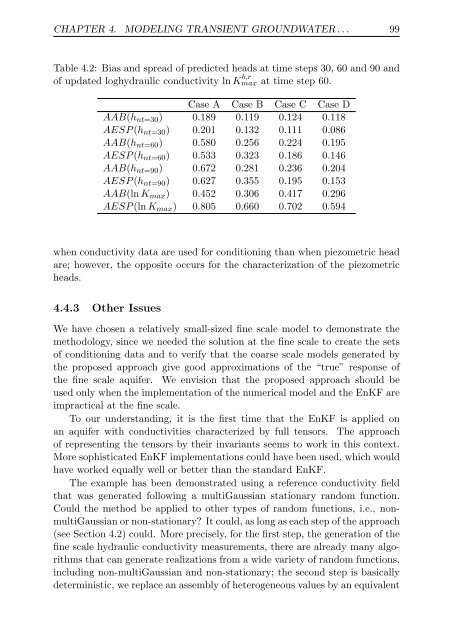Upscaling and Inverse Modeling of Groundwater Flow and Mass ...
Upscaling and Inverse Modeling of Groundwater Flow and Mass ...
Upscaling and Inverse Modeling of Groundwater Flow and Mass ...
Create successful ePaper yourself
Turn your PDF publications into a flip-book with our unique Google optimized e-Paper software.
CHAPTER 4. MODELING TRANSIENT GROUNDWATER . . . 99<br />
Table 4.2: Bias <strong>and</strong> spread <strong>of</strong> predicted heads at time steps 30, 60 <strong>and</strong> 90 <strong>and</strong><br />
<strong>of</strong> updated loghydraulic conductivity ln K b,r<br />
max at time step 60.<br />
Case A Case B Case C Case D<br />
AAB(hnt=30) 0.189 0.119 0.124 0.118<br />
AESP (hnt=30) 0.201 0.132 0.111 0.086<br />
AAB(hnt=60) 0.580 0.256 0.224 0.195<br />
AESP (hnt=60) 0.533 0.323 0.186 0.146<br />
AAB(hnt=90) 0.672 0.281 0.236 0.204<br />
AESP (hnt=90) 0.627 0.355 0.195 0.153<br />
AAB(ln Kmax) 0.452 0.306 0.417 0.296<br />
AESP (ln Kmax) 0.805 0.660 0.702 0.594<br />
when conductivity data are used for conditioning than when piezometric head<br />
are; however, the opposite occurs for the characterization <strong>of</strong> the piezometric<br />
heads.<br />
4.4.3 Other Issues<br />
We have chosen a relatively small-sized fine scale model to demonstrate the<br />
methodology, since we needed the solution at the fine scale to create the sets<br />
<strong>of</strong> conditioning data <strong>and</strong> to verify that the coarse scale models generated by<br />
the proposed approach give good approximations <strong>of</strong> the “true” response <strong>of</strong><br />
the fine scale aquifer. We envision that the proposed approach should be<br />
used only when the implementation <strong>of</strong> the numerical model <strong>and</strong> the EnKF are<br />
impractical at the fine scale.<br />
To our underst<strong>and</strong>ing, it is the first time that the EnKF is applied on<br />
an aquifer with conductivities characterized by full tensors. The approach<br />
<strong>of</strong> representing the tensors by their invariants seems to work in this context.<br />
More sophisticated EnKF implementations could have been used, which would<br />
have worked equally well or better than the st<strong>and</strong>ard EnKF.<br />
The example has been demonstrated using a reference conductivity field<br />
that was generated following a multiGaussian stationary r<strong>and</strong>om function.<br />
Could the method be applied to other types <strong>of</strong> r<strong>and</strong>om functions, i.e., nonmultiGaussian<br />
or non-stationary? It could, as long as each step <strong>of</strong> the approach<br />
(see Section 4.2) could. More precisely, for the first step, the generation <strong>of</strong> the<br />
fine scale hydraulic conductivity measurements, there are already many algorithms<br />
that can generate realizations from a wide variety <strong>of</strong> r<strong>and</strong>om functions,<br />
including non-multiGaussian <strong>and</strong> non-stationary; the second step is basically<br />
deterministic, we replace an assembly <strong>of</strong> heterogeneous values by an equivalent


